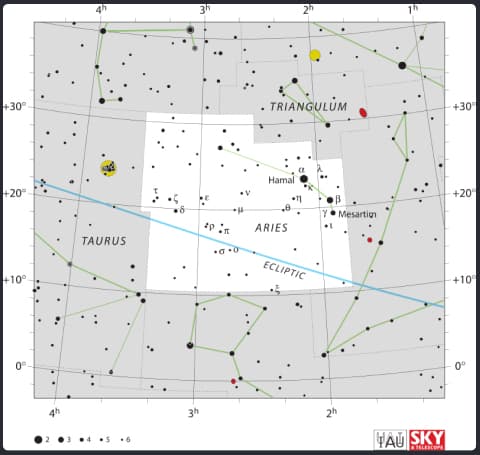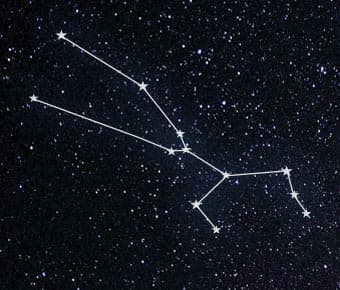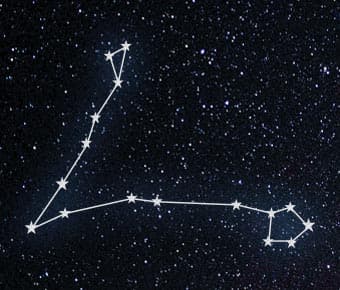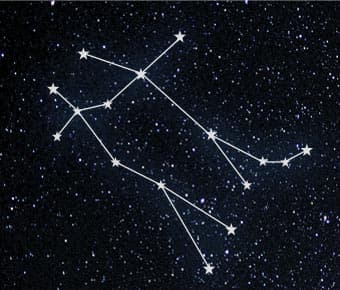The zodiac contains 13 unique star constellations, and one of those constellations is known as the Aries star constellation. The Aires constellation is exceptionally unique because the image that it depicts has changed over time. This is why some people tend to be confused about why Aries has two different images.
In this post, you can learn more about the Aries constellation’s interesting history, mythology, see what it looks like – and even learn when you can best see the Aries constellation in the UK sky!
The Mythology and History of the Aries Star Constellation
In Latin, Aries means a ram and is why these stars depict said animal. The image has been linked to figures from different mythologies. The most notable and referenced is the golden ram within Greek mythology. The golden ram came to the rescue of King Athamas’ children by the order of his first wife, in what was really a typical domestic problem involving an evil stepmother. In the end, the children were saved and the ram was sacrificed to Zeus. The ram’s fleece was kept and became known as the golden fleece. Interestingly, in later mythology, the same fleece was taken by Jason and his Argonauts.
Just like many other zodiac constellations, the Aries constellation was recorded by the great Greek thinker of the 2nd century, Ptolemy. However, Aries is not completely like other constellations because its symbolism and imagery has changed over time. The ancient Babylonians did not always depict the Aries constellation as a ram, and at one time, the constellation was depicted as a farmworker, also known as the agrarian worker. The exact point of time when the switch occurred has yet to be identified, and it is believed that the constellation was used to depict both images interchangeably for some time during later Babylonian times.

Source: Wikipedia
- Symbolism: the Water-Bearer
- Right ascension: 20h 38m 19.1706s– 23h 56m 23.5355s[1]
- Declination: 03.3256676°–−24.9040413°[1]
- Area: 980 sq. deg. (10th)
- Main stars: 10, 22
- Bayer/Flamsteed stars: 97
- Stars with planets: 12
- Brightest star: β Aqr (Sadalsuud) (2.91m)
What Does the Aries Constellation Even Look Like?
To create a constellation, certain stars are joined together to form an outline of an image. Of course, this new image of joined-up stars will not be elaborate or with fine details. Stargazers need to somewhat use their imagination to see the same images that were recorded from ancient times. For example, those looking at the Aries star constellation with a naked eye may not first see anything like a ram – or the even older image of a farm hand. Earlier medieval depictions of Aries as a ram showed the animal as it would if it was moving, almost like it was running through a field. More recent images have shown the constellation’s ram to be sitting with one outstretched leg.
Which Is the Brightest Star in the Aries Constellation?
The brightest star in the Aries constellation is called Hamal. This star also makes it into the top 50 brightest stars in the sky, coming in at 49th place. The star is an orange giant and twice as big as the Earth’s Sun. Other cool facts about Hamal include:
- It is considered a K-type star, which means it is neither relatively small nor large
- Hamal is 66 light years away from onlookers here on Earth
- The magnitude of Hamal varies between 1.98 to 2.04
If you want to know how many stars are in the Aries constellation in total, the answer is five. Another interesting star from the constellation is interestingly called Sheratan, which derives from an Arabic phrase meaning two signs. This is considered interesting due to the two depictions that the Aries constellation has been known to represent over time.
Where Is the Aries Constellation?
The Aries constellation is situated in the northern hemisphere’s first quadrant (NQ1). It takes up 441 square degrees. It is certainly not one of the largest constellations and measures in as the 39th largest star constellation. It can be seen on latitudes between +90 to -60 degrees.
The Aries constellation neighbours one of the biggest constellations, which is almost three times bigger than Aries, namely Cetus. It is also close to two other zodiac star constellations known as Pisces and Taurus. The latter has an interesting history dating back to the Bronze Age!
When Can I See the Aries Star Constellation in the UK?
The Aries constellation is best hunted down by stargazers in December, but it can also be spotted in the months on either side. If you do go looking for Aries in December, try to head out at 10pm when the star constellation is easiest seen. In November and January, the ideal time to look for Aries is 8pm and 6pm, respectively.
Aries is not one of the brightest constellations to look for. You will need low light pollution to see it best. The better news is that the ram’s head is noticeable and peers back on itself almost as though it is admiring its own beautiful fleece. Looking for these constellations can be a fun mini-adventure for the family, especially if you name a star after a loved one.
How Far Is the Aries Constellation from Us?
As we gather together on brisk wintery nights to marvel up at the night’s sky and the Aries constellation, your mind might start to wander and think about how far we are from these stars. Your head might start to hurt just trying to comprehend the distance between us and those stars. We’ll leave explaining time and space to the people at NASA and academics like Neil deGrasse Tyson.
However, what you should know is that those stars are not all the same distance away. Some are much closer to us than others. In fact, we are closer to two of the stars than those same two stars are to the remaining three stars in this constellation. The aforementioned Hamal and Sheratan are around 60-66 light years away, and the other three stars in the Aries constellation are 160+ light years from Earth.
More Fun Facts About the Aries Constellation
Not enough Aries constellation knowledge for one day? No problem! Here are some more fun facts about the Aries star constellation:
- The brightest star in the Aries constellation, Hamal, is derived from Arabic which literally means head of the ram!
- This constellation was not recognised by the International Astronomical Union (IAU) until 1992, despite being known since ancient times.
- The brightest stars of the constellation are located in the ram’s head.
Learn more about the different zodiac constellations and others soon by visiting us again at Star Name Registry!






